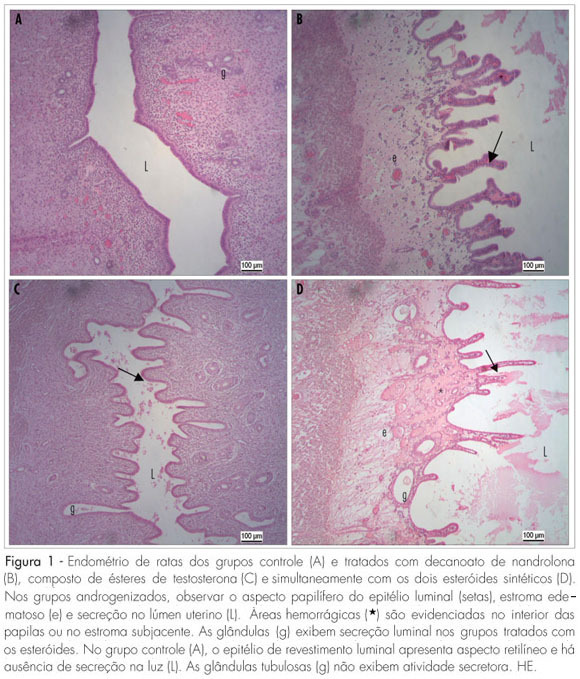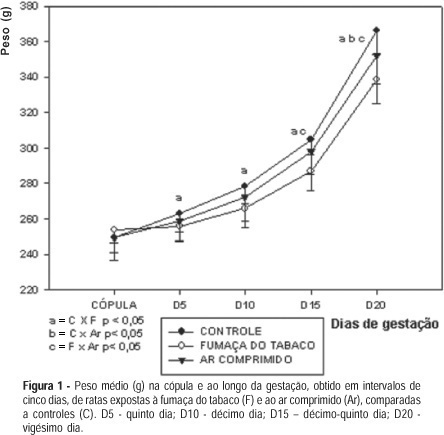Summary
Revista Brasileira de Ginecologia e Obstetrícia. 2010;32(8):374-380
DOI 10.1590/S0100-72032010000800003
PURPOSE: to evaluate the reactivity of VEGF-A and cleaved caspase-3 in the adrenal gland cortex of female pinealectomized rats treated with melatonin. METHODS: forty adult female rats were divided into 4 groups (G) of 10 animals: GI - no surgical intervention, with vehicle administration; GII - sham pinealectomized with vehicle administration; GIII - pinealectomized with vehicle administration; GIV - pinealectomized with melatonin administration (10 µg/animal) during the night. After 60 days of treatment, all animals were anesthetized, and the adrenal glands were removed and fixed in 10% formaldehyde (phosphate buffered) for histological processing and paraffin embedding. Sections (5 µm thick) were collected on silanized slides and submitted to imunnohistochemical methods for the detection of cleaved caspase-3 (apoptosis) and of vascular endothelial growth factor (VEGF-A) in the adrenal cortex. The data obtained were submitted to analysis of variance (ANOVA) complemented by the Tukey-Kramer test (p<0.05). RESULTS: reactivity to cleaved Caspase-3 was noted in the zona glomerulosa of the adrenal glands in all studied groups. There were no significant differences in the zona glomerulosa; however, the zona fasciculata (15.51±3.12*, p<0.05) and the zona reticularis (8.11±1.90*, p<0.05) presented the smallest percentage of apoptosis in the pinealectomized group (GIII). The reactivity to the VEGF-A was stronger in the zona glomerulosa and weaker in the zona reticularis in all groups. We found a stronger VEGF-A reactivity in the zona fasciculata in the pinealectomized group (GIII). CONCLUSIONS: the pineal gland affects the arrangement of the zona glomerulosa and reticularis of the adrenal glands, which are related to the production of sex hormones.

Summary
Revista Brasileira de Ginecologia e Obstetrícia. 2010;32(4):163-168
DOI 10.1590/S0100-72032010000400003
PURPOSE: to evaluate the effectiveness of the IUGR model by uterine artery ligation mimicking placental insufficiency in rats. METHODS: sprague-Dawley rat fetuses were divided into three groups: IUGR (intrauterine growth restriction), with fetuses in the right horn of pregnant rats subjected to right uterine artery ligation at 18.5 days of gestation (term = 22 days); C-IUGR (control of restriction), with control fetuses in the left horn, and EC (external control), with fetuses of intact rats. Animals were harvested by cesarean section at day 21.5 days of gestation. Fetuses were weighed and then sacrificed. The intestine, liver, kidney and placenta were weighed and dissected for morphometric and histological analysis. RESULTS: the morphometric data showed decreased body weight (BW), liver weight (LW) and intestinal weight (IW) of fetuses with IUGR compared to C-IUGR and EC (p<0.001). The placental weight (PW), renal weight (RW) and LW/BW, IW/BW, and RW/BW ratios did not change. IUGR fetuses had decreased kidney thickness (p<0.001) and decreased thickness of the intestinal mucosa and submucosa (p<0.05). Histological evaluation showed reduction of liver glycogen storage in fetuses with IUGR compared to C-IUGR and CE. CONCLUSIONS: the model described was efficient and caused symmetric fetal IUGR with decreased size of most organs, especially the liver, and changes in glycogen stores.

Summary
Revista Brasileira de Ginecologia e Obstetrícia. 2009;31(9):453-460
DOI 10.1590/S0100-72032009000900006
PURPOSE: to evaluate the effects of the administration of two synthetic steroids in the uterus morphology and in the reproductive parameters of adult female rats. METHODS: divided into four experimental groups: control (C; physiological solution); treated with nandrolone decanoate (DN; 7.5 mg/kg of body weight); with a testosterone esters compound (T; 7.5 mg/kg); and simultaneously with DN and T (7.5 mg/kg of each steroid), in a single intraperitoneal weekly dose, for eight weeks. Five females of each group were sacrificed and the uterine horns were collected, weighted and prepared for histological and morphometrical evaluation. The remaining rats were mated with normal male rats for reproductive parameters evaluation, composing the groups treated during the pre-gestational period. Another group of 20 female rats were treated during the gestational period (7th-14th days). For data analysis, the Kruskal-Wallis non-parametric variance analysis was used, followed by the test of Dunn or of Student-Newman-Keus (5% significance level). RESULTS: there was a significant body weight increase in the androgenized females (ND: 305±50; T: 280±35; ND+T: 275±30 versus C: 255±22 g; p<0.05). Uterine weight was not affected by the steroidal treatment (ND: 0.6±0.2; T: 0.4±0.04; ND+T: 0.7±0.1 versus C: 0.4±0.09 g). All the androgenized females presented estral acyclicity and endometrium characterized by papilliferous luminal lining, oedematous stroma with hemorrhagic areas and secretory activity. There were changes in the morphometrical thickness parameters of the luminal epithelium, myometrium and perimetrium in the androgenized groups. None of the female rats got pregnant when treated with steroids in the pre-gestational period and the treatment during organogenesis affected negatively the reproductive parameters. CONCLUSIONS: steroidal agents alter the uterine structure and impair fertility and gestational outcome in female rats.

Summary
Revista Brasileira de Ginecologia e Obstetrícia. 2006;28(3):143-150
DOI 10.1590/S0100-72032006000300002
PURPOSE: to analyze the effect of cigarette smoke on weight gain and food consumption of female pregnant rats, as well as of their offspring's weight and length at birth METHODS: Wistar rats were studied from the second day until the end of pregnancy. Fifty-one female rats were divided into three groups: Group F: 15 rats exposed to tobacco smoke (2 cigarettes/animal/day) plus air flush (10 L/min); Group Air: 18 rats exposed to air flush only (10 L/min); Group C: 18 non-exposed, non-manipulated controls. Body weight was measured every 5 days and food consumption every seven days (expressed as medium consumption per day). Offspring weight and length were measured on the first day of life. The Lavene test was used to verify the behavior of numeric variable distribution and for parametric one-way ANOVA analysis and Student's t test were used, according to the case. Results with p<0.05 were considered to be statistically significant. RESULTS: the rats of Group F consumed less food per day [Group F=18.9 g (±1.2) vs Group Air=21.7 g (±1,6) vs Group C=24.2g (±1,7); (p<0,05)], gained less weight during pregnancy than the animals of the air flush group and the control group: Group F=338.9 g (±13.7) vs Group Air=352.3g (±15,9) vs Group C=366.3 g (±13.1) (p<0.05). Pups birth weight and length were significantly smaller in the smoking group when compared to controls and to the air flush group, while these last two groups did not differ: Group F=5.5 g (±0.3) vs Group Air=5.9 g (±0,5) vs Group C=5.9 g (±0.4) - (p<0,01); Group F=6.8 cm (±0.2) vs Group Air=6.9 cm (±0,2) vs Group C=6.9 cm (±0.1) - (p<0.05), respectively. CONCLUSIONS: tobacco smoke exposure reduced the weight gain and food consumption during pregnancy and reduced the offspring weight and length evaluated at birth.

Summary
Revista Brasileira de Ginecologia e Obstetrícia. 2005;27(4):204-209
DOI 10.1590/S0100-72032005000400007
PURPOSE: to analyze the effects of isoflavones and estrogens on the morphology, morphometry and VEGF expression of the adult female rat mammary gland. METHODS: Forty-five adult female rats were oophorectomized; 28 days after surgery they were divided into 3 groups of 15 animals each: CON - control (treated with propylenoglycol); ISO - isoflavones (100 mg/kg) and CEE - conjugated equine estrogens (50 µg/Kg). Drugs or vehicle were given orally once a day for 60 days. After this, the animals were killed and the first pair of inguinal mammary glands was immediately removed; part of the material was processed for routine histological study and the remaining tissue was frozen for further analyses of the expression of VEGF mRNA by means of the RT-PCR technique. RESULTS: We observed that mammary ducts were atrophic in the control (CON) and isoflavone-treated (ISO) groups. In these groups the mammary glands were composed of a large concentration of adipose tissue with some ducts and rare alveolar structures. In the CEE group the ducts were well developed with many buds and alveolar structures. The number of mammary gland alveoli was higher in CEE than in the other groups (CON = 1.4 ± 2.1; ISO = 1.6 ± 3.8; CEE = 12.3 ± 7.1 alveoli/mm²; p<0.05%); also, the cell volume was higher (CON = 14.9 ± 4.9; ISO = 11.4 ± 6.9; CEE = 27.4 ± 9.7 µm³, p< 0.05%). The same was observed with regard to the number of blood vessels (CON = 16.4 ± 1.5; ISO = 18.4 ± 2.1; CEE = 37.1 ± 4.1 vessels/mm², p< 0.05). The expression of VEGF in the CEE group was higher than in the other groups, which did not significantly differ from each other in this respect. CONCLUSION: Our data did not show any proliferation effect in the mammary tissue of adult oophorectomized rats treated with isoflavones (100 mg/kg) during 60 days.
